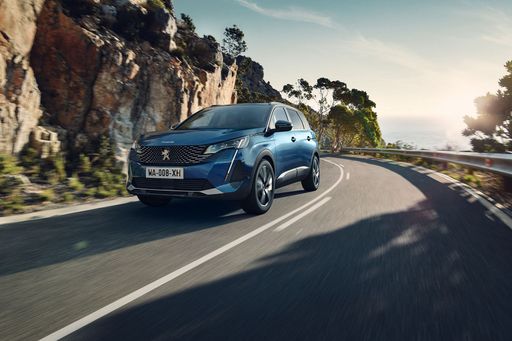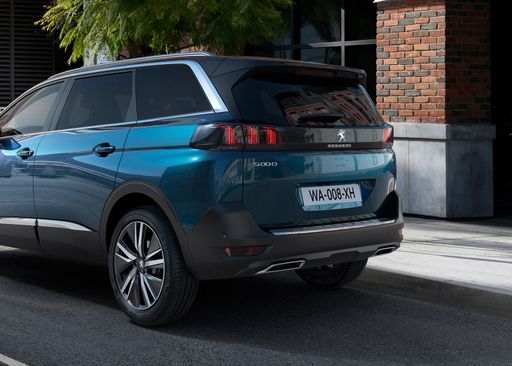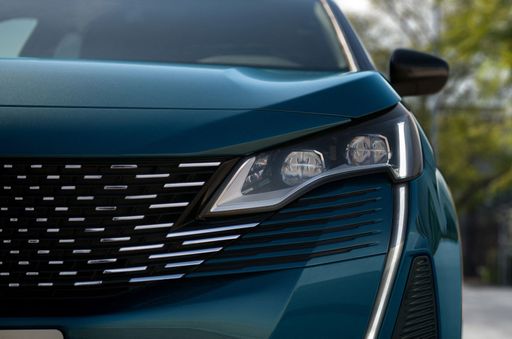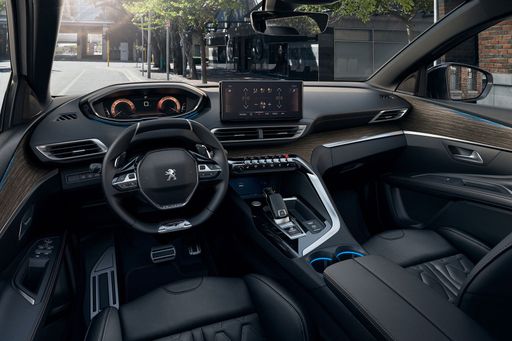Peugeot 5008 vs Renault Trafic Bus – Differences & prices compared
Compare performance, boot space, consumption and price in one view.
Find out now: which car is the better choice for you – Peugeot 5008 or Renault Trafic Bus?
The Peugeot 5008 (SUV) comes with a Plugin Hybrid, Electric or Petrol MHEV engine and Automatic transmission. In comparison, the Renault Trafic Bus (Bus) features a Diesel engine with Manuel or Automatic transmission.
When it comes to boot capacity, the Peugeot 5008 offers 994 L, while the Renault Trafic Bus provides – depending on how much space you need. If you’re looking for more power, decide whether the 325 HP of the Peugeot 5008 or the 170 HP of the Renault Trafic Bus suits your needs better.
In terms of consumption, the values are 17.80 kWh1 L per 100 km for the Peugeot 5008, and 6.80 L for the Renault Trafic Bus.
Price-wise, the Peugeot 5008 starts at 37000 £, while the Renault Trafic Bus is available from 38200 £. Compare all the details and find out which model fits your lifestyle best!
Peugeot 5008
The Peugeot 5008 impresses with its sleek design and spacious interior, making it an appealing choice for families and those needing extra room. Its elegant exterior lines are complemented by a well-crafted cabin that offers both comfort and versatility, ideal for longer journeys or everyday use. With a range of modern features and technology, the 5008 delivers a balanced blend of style and functionality that enhances the driving experience.
details @ media.stellantis.com
@ media.stellantis.com
 @ media.stellantis.com
@ media.stellantis.com
 @ media.stellantis.com
@ media.stellantis.com
 @ media.stellantis.com
@ media.stellantis.com
Renault Trafic Bus
The Renault Trafic Bus is a versatile and spacious option for those needing to transport multiple passengers comfortably. With its modern design and practical features, it is well-suited for both business and leisure purposes. Its efficient engine and smooth handling make it a reliable choice for long journeys.
details

|
|
|
|
|
Costs and Consumption |
|
|---|---|
|
Price
37000 - 53600 £
|
Price
38200 - 54400 £
|
|
Consumption L/100km
1 - 5.8 L
|
Consumption L/100km
6.8 - 7.2 L
|
|
Consumption kWh/100km
17.8 - 18.6 kWh
|
Consumption kWh/100km
-
|
|
Electric Range
78 - 674 km
|
Electric Range
-
|
|
Battery Capacity
0.4 - 96.9 kWh
|
Battery Capacity
-
|
|
co2
0 - 130 g/km
|
co2
179 - 189 g/km
|
|
Fuel tank capacity
55 L
|
Fuel tank capacity
80 L
|
Dimensions and Body |
|
|---|---|
|
Body Type
SUV
|
Body Type
Bus
|
|
Seats
5 - 7
|
Seats
8 - 9
|
|
Doors
5
|
Doors
4
|
|
Curb weight
1700 - 2406 kg
|
Curb weight
2031 - 2352 kg
|
|
Trunk capacity
294 - 994 L
|
Trunk capacity
-
|
|
Length
4791 mm
|
Length
5080 - 5480 mm
|
|
Width
1895 mm
|
Width
1956 mm
|
|
Height
1694 mm
|
Height
1973 - 1974 mm
|
|
Payload
534 - 699 kg
|
Payload
718 - 982 kg
|
Engine and Performance |
|
|---|---|
|
Engine Type
Plugin Hybrid, Electric, Petrol MHEV
|
Engine Type
Diesel
|
|
Transmission
Automatic
|
Transmission
Manuel, Automatic
|
|
Transmission Detail
Dual-Clutch Automatic, Reduction Gearbox
|
Transmission Detail
Manual Gearbox, Automatic Gearbox
|
|
Drive Type
Front-Wheel Drive, All-Wheel Drive
|
Drive Type
Front-Wheel Drive
|
|
Power HP
145 - 325 HP
|
Power HP
110 - 170 HP
|
|
Acceleration 0-100km/h
6.5 - 10.2 s
|
Acceleration 0-100km/h
10.6 - 16.5 s
|
|
Max Speed
170 - 220 km/h
|
Max Speed
161 - 180 km/h
|
|
Torque
230 - 511 Nm
|
Torque
300 - 380 Nm
|
|
Number of Cylinders
3 - 4
|
Number of Cylinders
4
|
|
Power kW
107 - 239 kW
|
Power kW
81 - 125 kW
|
|
Engine capacity
1199 - 1598 cm3
|
Engine capacity
1997 cm3
|
General |
|
|---|---|
|
Model Year
2024 - 2025
|
Model Year
2023 - 2025
|
|
CO2 Efficiency Class
B, A, D
|
CO2 Efficiency Class
G
|
|
Brand
Peugeot
|
Brand
Renault
|
Peugeot 5008
An Introduction to the Peugeot 5008: A Modern Marvel
The Peugeot 5008 is not just another SUV on the market; it represents a harmonious blend of innovation, style, and performance. A 2024 model year vehicle, the Peugeot 5008 redefines the expectations for modern SUVs with its state-of-the-art technology and robust design.
Cutting-edge Engine Options
The Peugeot 5008 offers a selection of power units, each meticulously designed to provide optimal performance and efficiency. Available with a choice between petrol mild-hybrids, plug-in hybrids, and a fully electric drivetrain, the 5008 ensures that every driver finds an option suited to their needs.
The petrol mild-hybrid features a 1.2-litre engine producing 136 PS, with a combined fuel consumption of 5.8 L/100 km, making it an economical choice for those concerned with fuel economy.
For those desiring a greener alternative, the 5008's plug-in hybrid variant combines a 1.6-litre engine with an electric motor, providing a robust 195 PS, exceptional fuel economy of 1 L/100 km, and an electric-only range of 78 km.
Finally, the fully electric e-5008, with an impressive 213 PS and a consumption of 17.8 kWh/100 km, offers a remarkable range of 500 km, satisfying drivers looking for a comprehensive electric experience.
Performance and Efficiency Meet Innovation
The Peugeot 5008 provides more than just electric and hybrid options; it is equipped with automatic transmission, ensuring a seamless driving experience. With front-wheel drive across the range, the 5008 balances power with efficiency. The model guarantees impressive acceleration, going from 0-100 km/h in just 8.8 to 10.2 seconds, and achieves top speeds between 170 and 220 km/h.
This vehicle offers CO2 efficiency classes ranging from A to D, underlining Peugeot's commitment to sustainable driving without compromising performance.
A Design That Captivates
Measuring 4,791 mm in length, 1,895 mm in width, and 1,694 mm in height, the Peugeot 5008 is an SUV that commands attention. Its spacious interior accommodates seven seats, with a boot capacity of 748 litres, ensuring ample space for family and cargo.
With a robust and sleek exterior, the 5008 doesn’t just offer practicality - it makes a statement on the road. Available in trims such as Allure and GT, the 5008 offers an aesthetic for both elegance and sportiness.
Seamless Technology and Safety
The Peugeot 5008 is equipped with the latest in automotive technology and safety features. Its automatic transmission options include both double-clutch gearboxes and reduction gear systems. A range of safety technologies combined with Peugeot's intuitive driving aids ensure safety is paramount.
Innovative features and advanced driver assistance systems, such as adaptive cruise control and lane-keeping assist, equip the 5008 to navigate roads with ease and confidence.
Conclusion: The Future is Here
The Peugeot 5008 emerges as a versatile contender in the SUV market, offering a mix of stylish design, forward-thinking technology, and strong performance credentials. With options for every driving preference, the 5008 is truly a testament to Peugeot’s vision for the future of mobility.
Renault Trafic Bus
A Glimpse into the Renault Trafic Bus: An Icon of Versatility and Innovation
Amongst the plethora of vans designed for both business and leisure, the Renault Trafic Bus stands out as an exemplar of functionality, innovation, and style. Let's delve into what makes the Renault Trafic Bus a popular choice in the UK and across Europe, particularly focusing on its technical specifications and state-of-the-art features.
Performance Dynamics: Power Under the Hood
The Renault Trafic Bus, a staple in Renault's fleet, is driven by a robust diesel engine configuration with power outputs ranging from 110 PS to a formidable 170 PS. The diesel engines combine efficiency and power, offering torque figures between 300 to 380 Nm, ensuring smooth power delivery and capable load hauling.
Drivers can choose between manual and automatic transmissions, both designed to complement the Trafic's front-wheel-drive system. This flexibility ensures that drivers experience enhanced driving comfort whether they are navigating urban roads or cruising on the motorway.
Efficiency Meets Economy
The Trafic Bus showcases impressive fuel economy with consumption figures ranging from 6.8 to 7.2 litres per 100 kilometres. This efficiency is crucial for businesses aiming to minimise operational costs and for families seeking budget-friendly travel options.
With a generous fuel tank capacity of 80 litres, the Renault Trafic Bus is built to cover long distances with fewer fuel stops, making it an ideal choice for long haul journeys.
Technological Innovations and Comfort
The Trafic Bus isn't just about robust performance. Renault has integrated a suite of technological innovations designed to enhance driver and passenger comfort. Its cabins are equipped with the latest infotainment systems and safety technologies, providing an optimal blend of comfort and convenience.
The various trims, such as Life, Start, Spaceclass, and their respective EDC variants, cater to different needs and preferences, ensuring that customers can find the perfect configuration for their requirements.
Design and Dimensions: Space for Every Purpose
Space and versatility are at the heart of the Trafic Bus design. With its dimensions ranging from a length of 5080 to 5480 mm, and a width of 1956 mm, this vehicle offers ample room for passengers and cargo alike. The height stands between 1973 and 1974 mm, ensuring that even taller individuals can travel comfortably.
With seating for up to eight people and a payload capacity between 730 to 1010 kg, the Trafic Bus can transform seamlessly between a people-mover and a goods carrier.
Environmental Considerations
Renault has engineered the Trafic Bus with environmental responsibility in mind. The CO2 emissions range from 178 to 190 g/km, which, while modest for its class, aligns with the efficiency and performance goals set for this versatile vehicle. The CO2 efficiency class is rated as 'G', offering transparency in its environmental impact profile.
Conclusion: A Leader in Its Class
The Renault Trafic Bus continues to lead its segment through a blend of power, efficiency, and technological advancements. Whether it's for commercial transport or family adventures, the Trafic offers a reliable and adaptable solution, setting a high standard for multi-purpose vehicles.
For those seeking a distinguished blend of utility and comfort, the Renault Trafic Bus emerges as an exceptional choice, promising performance and innovation on every journey.
Which drive types are available for the Peugeot 5008?
Available as Front-Wheel Drive or All-Wheel Drive.
The prices and data displayed are estimates based on German list prices and may vary by country. This information is not legally binding.
